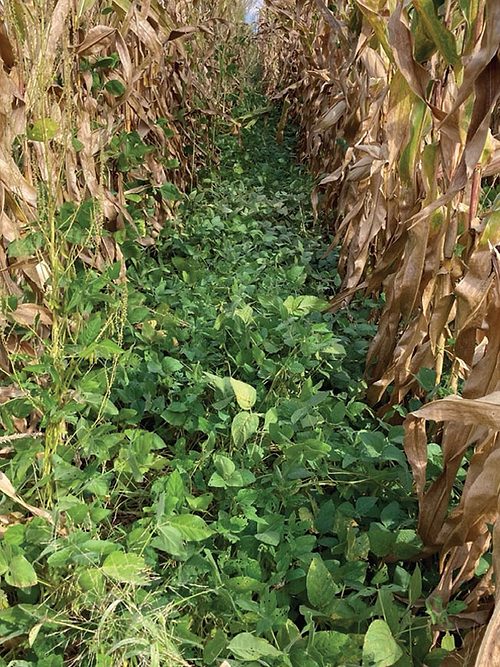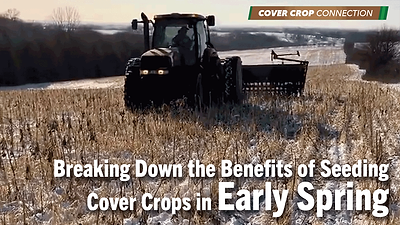It is a generally well known fact that the growth of lush cover crops in your corn field requires a lot of well-focused and skilled deployment with basic, critically important attention to your objectives, seed selection, soil and its nutrient and microbiological balance, the soil's available water holding capacity, and more.
Assuming you have achieved the challenging feat of accomplishing all of above to the extent required for the emergence of a good stand of cover crop, incident sunlight soon becomes the most limiting factor for subsequent plant growth.
A viable solution to this most limiting factor, however, may not be as generally well known, or as direct as adding more of any one commercially available production input. Accordingly, a properly deployed solar corridor occurring between widely spaced corn rows enables or offers that viable solution.
Sunshine, captured as incident sunlight by the chloroplasts principally found in the chlorophyll-rich green leaf, is converted into photosynthetically active radiation before making use of the other essential elements, is the vital source of subsequent plant growth. This photo-chemical energy captures current carbon cycle carbon dioxide (CO2) in the biosynthesis process.
God-given sunshine, CO2 and — in the case of rain-fed agriculture — water are all used in the initial biosynthesis process, and are provided without, direct or indirect, monetary cost. However, those who irrigate know first hand that sunshine and carbon dioxide are the only crop production resources that come without requiring an annual monetary cost. That cost factor and their near infinite and actually infinite supply, respectively, makes this article one that I like to discuss with those who want to consider using solar corridors on their farms.
Carbon Source
Whether it is harvested by or for livestock or returned to the soil, carbon is by far the largest dry matter component of cover crop growth. The solar corridor offers an idea of how to potentially provide both sunlight capture and dry matter for successful cover crop production in your corn field. The solar corridor is the enabling component of an innovative site and cultivar specific interdisciplinary crop system, which focuses on delivering the extra ingredients required by this popular adaptation of the solar corridor as a proven foundation for a potential Solar Corridor Crop System for your farm.
This article focuses the extra ingredients required on cover crops in the solar corridor and, accordingly, doesn’t specifically address the other essential crop production factors. But rest assured, if incident sunlight is your most limiting factor and you are able to remove that most limiting factor to some significant degree, you do increase the potential production efficiency of the other production factors, such as soil moisture, until each successive most limiting factor is reached and removed. Subsequent system adjustments can turn that potential into actual increased production efficiency.
What Is a Solar Corridor?
A solar corridor is the space between rows of a relatively tall plant like corn that is wide enough for significant amounts of incident sunlight to reach the cover crop growing between the corn rows. The covers between the rows become another tool for your crop production toolbox. If planting corn in 30-38 inch rows, removing every other corn row creates an easy to plant, effective and popular-sized solar corridor.
Moving each removed row to within 6-8 inches of the next row to the right (or left) creates a twin-row solar corridor. The twin row removes the necessity of increasing in row plant population to maximize corn yield. The single-row solar corridor has been most popular, but the twin-row solar corridor row configuration, which was awarded U.S. Patent 6052941 for “Plant Arrangement for Improving Crop Yield,” has been the higher yielding option for corn. Essentially all of my published corn yield results since 2000 have been from solar corridors created by a twin-row spaced every 60 or 72 inches. I’m unaware of any published research, but my hypothesis suggests that, due to the population intensity within the single row vs. the more staggered plant placement in the twin row, the twin row could also contribute to higher cover crop yields.
The solar corridor's width, configuration and frequency in the field has some flexibility to suit your conditions. My experience has shown that if your corn grows to normal height, 60-inch and 72-inch twin row solar corridors have proven to be very effective. Taller corn could possibly benefit from a wider solar corridor, while short corn possibly could get by with less than 60 inches. My simple objective is for incident sunlight to reach the cover crop. The width of the solar corridor guides the depth and daily duration of its potential impact.
We identify the tall crop that creates the solar corridors as the main crop, and the complementary crop that grows between the widely spaced rows as the floor crop.
A floor crop potentially complements soil health and/or adds yield to the main crop yield. For example, specific cover crops can increase soil carbon (C), nitrogen (N), microbiological activity and diversity like beneficial soil mycorrhizae, living roots in the ground, soil moisture holding capacity, narrowing the C:N ratio and many other contributors to soil health. Depending on the cover crop species, the floor crop can also reduce specific insect pests, mobile nutrient loss, soil erosion and compaction, crop lodging and more, while simultaneously improving sustainable crop yield. A solar corridor is the unique basic component of the properly designed, developed and deployed Solar Corridor Crop System.
How Does a Solar Corridor Increase Crop Yield?
A solar corridor enables the growing crop(s) to convert more of the incident sunlight that shines on the farm field into photosynthetically active solar radiation, which enables greater solar radiation use efficiency and increases the subsequent biosynthesis of ambient CO2 through nature's most productive process, photosynthesis.
Subject to specific air movement patterns and crop canopy impacts, the properly designed, developed and deployed Solar Corridor Crop System delivers additional amounts of current carbon cycle sourced CO2 into ambient CO2. Accordingly, greater capture and utilization of incident sunlight — the system's most limiting factor — and ambient CO2 is achieved. Additionally, the microclimate of the corn field is dramatically changed in multiple ways. Air movement through the canopy and down the rows has multiple impacts on the crop, crop fungal diseases, insects, deer, the production environment and more. The solar corridor thereby utilizes the interdisciplinary synergies enabled to serve various objectives of the farmer who chooses to potentially develop a site- and cultivar-specific Solar Corridor Crop System.
At above trend line yields, we produced at least as much corn from one 60-inch twin row as we produced in two 30-inch rows. Plus, we got an additional yield from a unique floor crop without reducing corn yield. The data illustrating this conclusion appeared in our patent referenced above; a peer review paper by Deichman, Kremer & Lupo; and Chapter 2 of the first edition of "The Solar Corridor Crop System: Implementation and Impacts." Yield tables 1-14 and the bottom line of the patent, as well as my classroom presentation at the 2023 National No-Till Conference, gave specific info on the obvious hybrid specific aspects of corn yield. The takeaway is don’t select corn hybrids for the solar corridor without reviewing any one of the 4 previous references above.
In 2000, I began presenting the original research studies that were conducted over the previous 10 years with hybrids produced in the 1980s before GMO hybrids were offered for sale. The yield data of those studies, across a wide range of soils at 40-41 degrees latitude in Illinois showed that we produced as much or more corn in 60 or 72-inch wide twin rows from the 3 hybrids selected by our preliminary hybrid screening trials compared to control plots with the same hybrids. We chose hybrids based on two factors: 1. their control yields and 2. how the high-yielding, non-responsive hybrid produced under what were best management practices at the time. That response conclusion was replicated by 1 of 2 GMO triple-stacked hybrids in Table 2 in this research article from The American Society of Agronomy in 2014. Thus, both non-GMO and GMO hybrids are responsive to the solar corridor.
Depending on your objectives, you may choose to relax the requirement of producing as much corn and focus more on other goals. For example, your focus could be on having pasture-ready cover crop growth by corn harvest, rather than obtaining higher corn yield. Cover crop species, seeding methods, rates and dates, and more are management decisions based on the relative allocation to main crop or floor crop. Incidentally, the innovative farmers I’ve had the opportunity to work with on cover crops in the solar corridor all know more on how to implement cover crops in the solar corridor on their farms than this interdisciplinary corn production agronomist does.
Related Content
Improving Profitability by Interseeding Wide-Row Corn with Cover Crops




